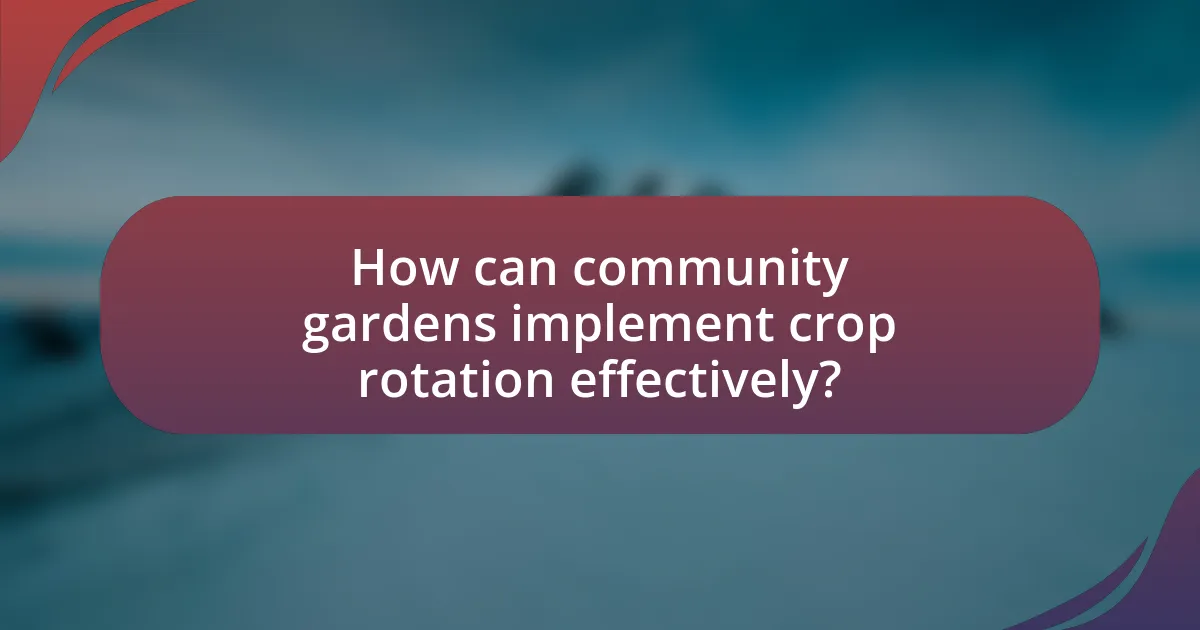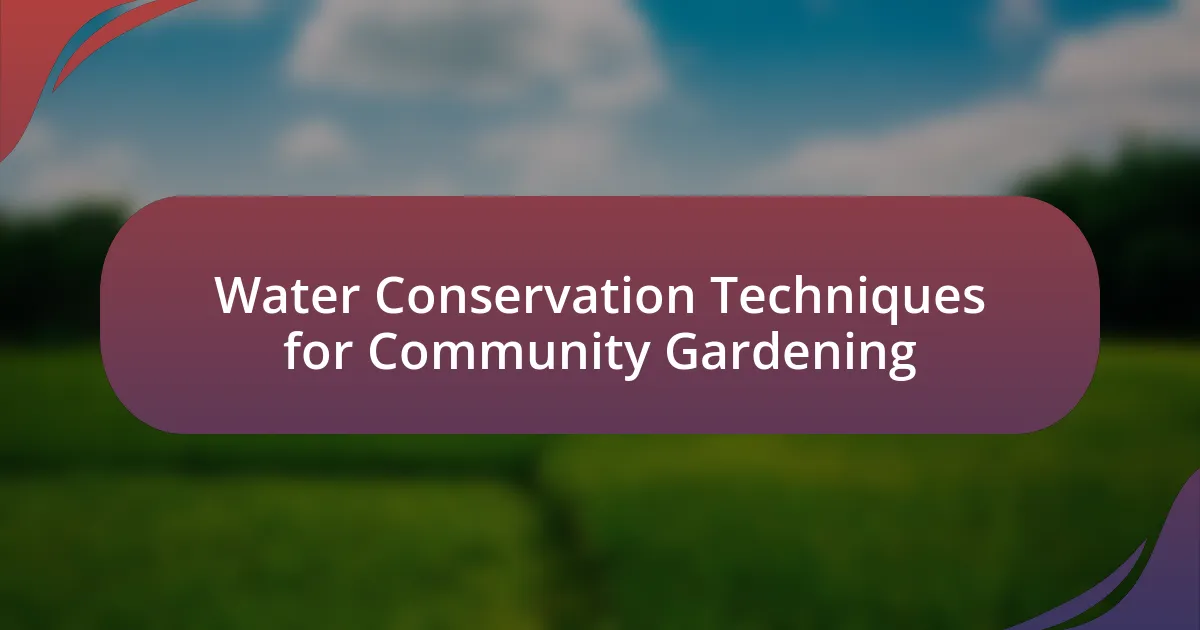Effective crop rotation methods for community gardens are essential for maintaining soil health, enhancing biodiversity, and improving crop yields. Key strategies include rotating crops based on their families, utilizing cover crops, and implementing a systematic four-year rotation plan. These practices help prevent soil nutrient depletion, reduce pest and disease pressure, and promote sustainable gardening. The article also addresses the ecological advantages of crop rotation, common challenges faced by community gardens, and practical tips for successful implementation, emphasizing the importance of community involvement and education in optimizing crop rotation practices.

What are Effective Crop Rotation Methods for Community Gardens?
Effective crop rotation methods for community gardens include rotating crops based on their families, utilizing cover crops, and implementing a four-year rotation plan. Rotating crops by family helps prevent soil nutrient depletion and reduces pest and disease buildup, as different plant families have varying nutrient needs and pest profiles. For instance, legumes can fix nitrogen in the soil, benefiting subsequent crops. Cover crops, such as clover or rye, can be planted during off-seasons to improve soil health and prevent erosion. A four-year rotation plan, where different types of crops are planted in a specific sequence, can enhance soil fertility and crop yield by ensuring that no single nutrient is overused. Studies have shown that these methods can significantly improve soil structure and fertility, leading to healthier plants and higher yields in community gardens.
How does crop rotation benefit community gardens?
Crop rotation benefits community gardens by enhancing soil health, reducing pest and disease pressure, and improving crop yields. By alternating different types of crops, community gardens can maintain nutrient balance in the soil, as different plants have varying nutrient requirements and contributions. For instance, legumes can fix nitrogen in the soil, enriching it for subsequent crops. Additionally, rotating crops disrupts the life cycles of pests and diseases that may thrive on specific plants, leading to healthier plants and reduced reliance on chemical pesticides. Research indicates that implementing crop rotation can increase yields by up to 20% in various agricultural settings, demonstrating its effectiveness in promoting sustainable gardening practices.
What are the ecological advantages of crop rotation?
Crop rotation offers significant ecological advantages, including improved soil health, enhanced biodiversity, and reduced pest and disease pressure. By alternating crops, soil nutrients are replenished, as different plants have varying nutrient requirements and root structures, which helps maintain soil fertility and structure. Research indicates that crop rotation can increase soil organic matter by up to 30%, leading to better water retention and reduced erosion. Additionally, rotating crops disrupts the life cycles of pests and diseases, decreasing their prevalence and reliance on chemical pesticides. Studies show that farms practicing crop rotation experience a 10-20% reduction in pest populations compared to monoculture systems. Overall, these practices contribute to a more sustainable and resilient agricultural ecosystem.
How does crop rotation improve soil health?
Crop rotation improves soil health by enhancing nutrient availability and reducing soil erosion. By alternating different crops, farmers can prevent nutrient depletion, as various plants have distinct nutrient requirements and contribute different organic matter to the soil. For instance, legumes fix nitrogen in the soil, enriching it for subsequent crops. Additionally, crop rotation disrupts pest and disease cycles, leading to healthier plants and reduced reliance on chemical fertilizers and pesticides. Research indicates that fields with diverse crop rotations can yield up to 20% more than monoculture systems, demonstrating the effectiveness of this practice in maintaining soil vitality.
What principles guide effective crop rotation?
Effective crop rotation is guided by principles such as diversity, nutrient management, and pest control. Diversity involves alternating different plant families to disrupt pest and disease cycles, which enhances soil health and reduces reliance on chemical inputs. Nutrient management focuses on rotating crops with varying nutrient requirements; for example, legumes can fix nitrogen in the soil, benefiting subsequent crops. Pest control is achieved by rotating crops to break the life cycles of pests and diseases, minimizing their impact on future plantings. These principles are supported by agricultural studies indicating that diverse crop rotations can increase yields and improve soil structure, ultimately leading to more sustainable gardening practices.
What is the significance of plant families in crop rotation?
Plant families are significant in crop rotation because they help manage soil health, pest control, and nutrient cycling. By rotating crops from different plant families, farmers can reduce the risk of soil-borne diseases and pests that target specific plants, as many pests and diseases are family-specific. For example, rotating legumes with brassicas can enhance soil nitrogen levels while minimizing the buildup of pathogens. Additionally, different plant families have varying nutrient requirements and root structures, which can improve soil structure and fertility over time. This practice is supported by agricultural studies showing that diverse crop rotations lead to higher yields and healthier ecosystems.
How does timing affect crop rotation strategies?
Timing significantly affects crop rotation strategies by determining the optimal planting and harvesting periods for different crops. Proper timing ensures that crops are rotated in a way that maximizes soil health, minimizes pest and disease cycles, and enhances nutrient availability. For instance, rotating legumes, which fix nitrogen, with nitrogen-demanding crops like corn can improve soil fertility when timed correctly with the growing seasons. Research indicates that implementing a well-timed crop rotation can increase yields by up to 20% compared to continuous cropping systems, as demonstrated in studies conducted by the USDA Agricultural Research Service.
What challenges do community gardens face with crop rotation?
Community gardens face several challenges with crop rotation, primarily due to limited space and diverse planting schedules. Limited space restricts the ability to rotate crops effectively, as gardeners may not have enough area to implement a full rotation cycle. Additionally, the diverse planting schedules of various gardeners can lead to inconsistencies in crop rotation practices, making it difficult to coordinate and manage the timing of planting and harvesting. These challenges can result in soil nutrient depletion and increased pest and disease pressure, ultimately affecting the overall productivity and sustainability of the garden.
How can community gardens overcome pest and disease issues?
Community gardens can overcome pest and disease issues by implementing integrated pest management (IPM) strategies, which include crop rotation, companion planting, and the use of organic pesticides. Crop rotation disrupts the life cycles of pests and diseases by alternating the types of crops grown in a specific area, reducing the likelihood of infestations. For example, rotating legumes with leafy greens can enhance soil health and deter pests that target specific crops. Companion planting, such as growing marigolds alongside vegetables, can repel harmful insects and attract beneficial ones. Additionally, organic pesticides, derived from natural sources, can effectively manage pest populations without harming the ecosystem. Research indicates that these methods can significantly reduce pest incidence and improve overall garden health, making them effective practices for community gardens.
What are the common mistakes in crop rotation practices?
Common mistakes in crop rotation practices include failing to diversify crops, not considering soil health, and neglecting pest and disease management. Diversification is crucial; planting the same crop repeatedly can deplete specific nutrients and increase pest populations. Additionally, ignoring soil health can lead to nutrient imbalances and reduced fertility over time. Effective crop rotation should also incorporate strategies for managing pests and diseases, as certain crops can harbor pathogens that affect subsequent plantings. Research indicates that proper rotation can enhance soil structure and fertility, ultimately leading to better yields and healthier plants.

How can community gardens implement crop rotation effectively?
Community gardens can implement crop rotation effectively by planning a systematic schedule that alternates different plant families in designated plots each growing season. This method reduces soil nutrient depletion and minimizes pest and disease buildup, as different crops have varying nutrient requirements and pest profiles. Research indicates that rotating crops such as legumes, which fix nitrogen, with heavy feeders like tomatoes can enhance soil fertility and yield. Additionally, maintaining records of crop placement and performance helps gardeners optimize future rotations, ensuring a balanced ecosystem and sustainable gardening practices.
What steps should be taken to plan a crop rotation schedule?
To plan a crop rotation schedule, first assess the soil health and nutrient needs of the crops. This involves testing the soil for nutrient levels and pH to determine which crops will thrive. Next, select a diverse range of crops that belong to different plant families to minimize pest and disease buildup. For example, rotating legumes with brassicas can enhance soil nitrogen levels while reducing pest populations.
Then, create a timeline that outlines when each crop will be planted and harvested, ensuring that crops with similar growing seasons are grouped together. It is also essential to document the previous crops planted in each section of the garden to avoid planting the same family in consecutive seasons, which can lead to nutrient depletion and increased disease risk.
Finally, regularly review and adjust the rotation plan based on crop performance and soil health observations, ensuring that the schedule remains effective over time. This method is supported by agricultural studies indicating that proper crop rotation can improve yields and soil fertility.
How do you assess soil conditions before planning?
To assess soil conditions before planning, conduct a soil test to evaluate pH, nutrient levels, and organic matter content. Soil tests provide quantitative data that informs decisions on amendments needed for optimal crop growth. For instance, a study by the USDA Natural Resources Conservation Service indicates that soil pH affects nutrient availability, with most crops thriving in a pH range of 6.0 to 7.5. Additionally, examining soil texture through a simple jar test can reveal drainage capabilities and moisture retention, which are crucial for selecting appropriate crops for rotation.
What tools can assist in creating a crop rotation plan?
Tools that can assist in creating a crop rotation plan include crop rotation software, garden planning apps, and spreadsheets. Crop rotation software, such as Crop Planning Software, allows users to input their specific crops and receive tailored rotation suggestions based on best practices. Garden planning apps like GrowVeg provide visual layouts and reminders for planting schedules, ensuring effective rotation. Additionally, spreadsheets can be customized to track crop history, nutrient needs, and planting dates, facilitating a systematic approach to crop rotation. These tools enhance planning accuracy and help maintain soil health, which is crucial for sustainable gardening practices.
What crops are best suited for rotation in community gardens?
Legumes, brassicas, and root vegetables are best suited for rotation in community gardens. Legumes, such as beans and peas, enrich the soil with nitrogen, improving fertility for subsequent crops. Brassicas, including cabbage and kale, help break pest cycles and can be followed by nutrient-demanding crops. Root vegetables like carrots and beets can improve soil structure and reduce compaction, making them ideal for rotation. This practice enhances soil health, reduces disease risk, and maximizes yield, as supported by agricultural studies emphasizing the benefits of crop diversity in sustainable gardening.
Which vegetables are most beneficial for soil enrichment?
Legumes, such as peas and beans, are the most beneficial vegetables for soil enrichment. These plants have the unique ability to fix nitrogen in the soil through their symbiotic relationship with Rhizobium bacteria, which convert atmospheric nitrogen into a form that plants can use. This process enhances soil fertility and improves the overall health of the soil ecosystem. Additionally, crops like clover and vetch, which are often used as cover crops, also contribute to soil enrichment by adding organic matter and improving soil structure when tilled back into the ground.
How can seasonal crops be integrated into rotation plans?
Seasonal crops can be integrated into rotation plans by strategically alternating them with other crops to enhance soil health and optimize yield. This practice involves scheduling the planting of seasonal crops, such as tomatoes or cucumbers, in a sequence that allows for nutrient replenishment and pest management. For instance, following a heavy feeder like corn with a nitrogen-fixing crop such as beans can improve soil fertility. Research indicates that crop rotation can reduce pest populations by disrupting their life cycles, leading to healthier plants and increased productivity.
What role does community involvement play in crop rotation?
Community involvement plays a crucial role in crop rotation by fostering collaboration among gardeners, which enhances knowledge sharing and resource management. Engaged communities can collectively plan crop rotations that optimize soil health and pest control, leading to increased yields. For instance, community gardens that implement crop rotation benefit from diverse planting strategies, as members contribute their expertise and experiences, resulting in more effective practices. Research indicates that community participation in agricultural practices can lead to improved sustainability and productivity, as seen in studies highlighting the success of community-driven initiatives in urban gardening.
How can gardeners collaborate to share knowledge and resources?
Gardeners can collaborate to share knowledge and resources through community gardening groups, workshops, and online platforms. These collaborative efforts allow gardeners to exchange best practices, share tools, and provide support for crop rotation methods, which are essential for maintaining soil health and maximizing yields. For instance, community gardens often host regular meetings where members discuss their experiences and strategies, fostering a culture of learning and resource sharing. Additionally, online forums and social media groups enable gardeners to connect beyond geographical boundaries, facilitating the exchange of information and resources such as seeds and gardening techniques. Studies have shown that collaborative gardening initiatives can lead to improved crop diversity and sustainability, highlighting the effectiveness of shared knowledge in enhancing community gardening efforts.
What educational programs can support effective crop rotation?
Educational programs that can support effective crop rotation include university extension services, community workshops, and online courses focused on sustainable agriculture practices. University extension services often provide research-based information and resources tailored to local agricultural conditions, helping farmers and gardeners understand the benefits of crop rotation. Community workshops facilitate hands-on learning experiences, allowing participants to engage directly with crop rotation techniques. Online courses, such as those offered by platforms like Coursera or edX, provide accessible education on sustainable farming practices, including crop rotation strategies, enabling a broader audience to learn and implement these methods effectively.

What are the best practices for maintaining crop rotation in community gardens?
The best practices for maintaining crop rotation in community gardens include planning diverse crop sequences, monitoring soil health, and educating gardeners on the importance of rotation. Implementing a rotation plan that alternates crops from different families helps prevent soil nutrient depletion and reduces pest and disease cycles. Regular soil testing can inform gardeners about nutrient levels and pH, allowing for adjustments that support healthy plant growth. Additionally, community workshops can enhance understanding of crop rotation benefits, fostering a collaborative approach to sustainable gardening practices.
How can gardeners monitor the success of their crop rotation?
Gardeners can monitor the success of their crop rotation by tracking soil health, pest populations, and crop yields over time. By regularly testing soil nutrient levels and pH, gardeners can assess improvements or declines in soil quality, which indicates the effectiveness of their rotation strategy. Additionally, observing pest and disease occurrences can reveal whether crop rotation is successfully disrupting pest life cycles, as certain crops can attract or repel specific pests. Finally, comparing the yields of rotated crops against previous seasons provides quantitative data on the benefits of rotation, with studies showing that proper crop rotation can increase yields by 10-30% in various crops.
What indicators show that crop rotation is effective?
Indicators that show crop rotation is effective include improved soil health, increased crop yields, and reduced pest and disease incidence. Improved soil health is evidenced by enhanced nutrient availability and organic matter content, which can be measured through soil tests. Increased crop yields can be quantified by comparing harvest data before and after implementing crop rotation practices, often showing a significant rise in productivity. Additionally, reduced pest and disease incidence can be observed through lower pest populations and disease outbreaks, supported by field observations and pest monitoring data, indicating that diverse cropping systems disrupt pest life cycles and enhance plant resilience.
How can gardeners adjust their plans based on observations?
Gardeners can adjust their plans based on observations by closely monitoring plant health, soil conditions, and pest activity. For instance, if a gardener notices that certain crops are not thriving due to poor soil quality, they can amend the soil with organic matter or change the crop selection to more suitable varieties. Additionally, observing pest patterns allows gardeners to implement integrated pest management strategies, such as rotating crops to disrupt pest life cycles. Research indicates that effective crop rotation can enhance soil fertility and reduce disease incidence, supporting the need for adjustments based on real-time observations.
What resources are available for community gardeners on crop rotation?
Community gardeners can access various resources on crop rotation, including extension services, online guides, and workshops. Agricultural extension services, often provided by universities, offer research-based information tailored to local conditions, including crop rotation strategies. Online platforms such as the USDA’s Sustainable Agriculture Research and Education (SARE) program provide comprehensive guides and case studies on effective crop rotation practices. Additionally, local gardening clubs and community organizations frequently host workshops and seminars that focus on crop rotation techniques, allowing gardeners to learn from experts and share experiences. These resources collectively support community gardeners in implementing effective crop rotation methods to enhance soil health and crop yields.
Where can gardeners find guides and tools for crop rotation?
Gardeners can find guides and tools for crop rotation through agricultural extension services, gardening websites, and local gardening clubs. Agricultural extension services, often affiliated with universities, provide research-based resources and publications on crop rotation practices. Websites like the USDA’s National Agricultural Library and gardening platforms such as the Old Farmer’s Almanac offer comprehensive guides and tools tailored for various gardening needs. Additionally, local gardening clubs frequently host workshops and distribute materials that focus on effective crop rotation methods, making them valuable resources for gardeners seeking practical advice.
What online communities support crop rotation practices?
Online communities that support crop rotation practices include the Permaculture Research Institute, which offers forums and resources for sustainable agriculture, and the Gardening Subreddit on Reddit, where users share experiences and advice on crop rotation. Additionally, the Facebook group “Organic Gardening” provides a platform for discussions on crop rotation techniques among organic gardeners. These communities facilitate knowledge exchange and practical tips, reinforcing the importance of crop rotation in sustainable gardening practices.
What practical tips can enhance crop rotation success in community gardens?
To enhance crop rotation success in community gardens, gardeners should implement a systematic rotation plan that includes diverse plant families, such as legumes, brassicas, and nightshades. This diversity helps prevent soil nutrient depletion and reduces pest and disease buildup. For instance, rotating legumes, which fix nitrogen in the soil, with nitrogen-hungry crops like corn can improve soil fertility. Additionally, maintaining detailed records of planting schedules and crop performance allows gardeners to analyze and adjust their rotation strategies effectively. Research indicates that following these practices can lead to increased yields and healthier plants, as evidenced by studies showing that crop rotation can improve soil health and reduce reliance on chemical fertilizers.





